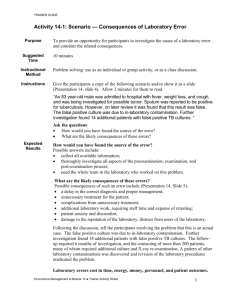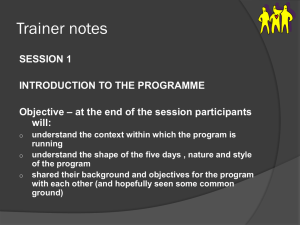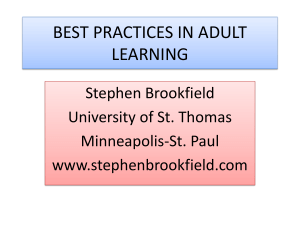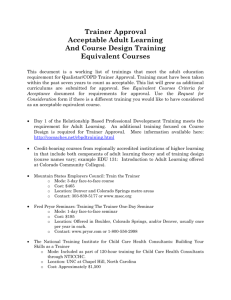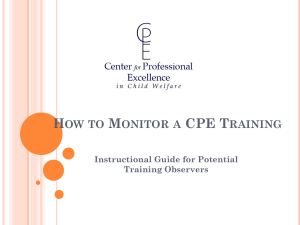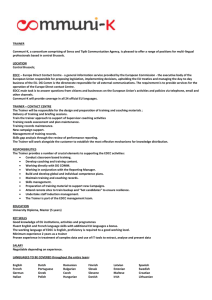Activity sheet X-X : Sample Management
advertisement
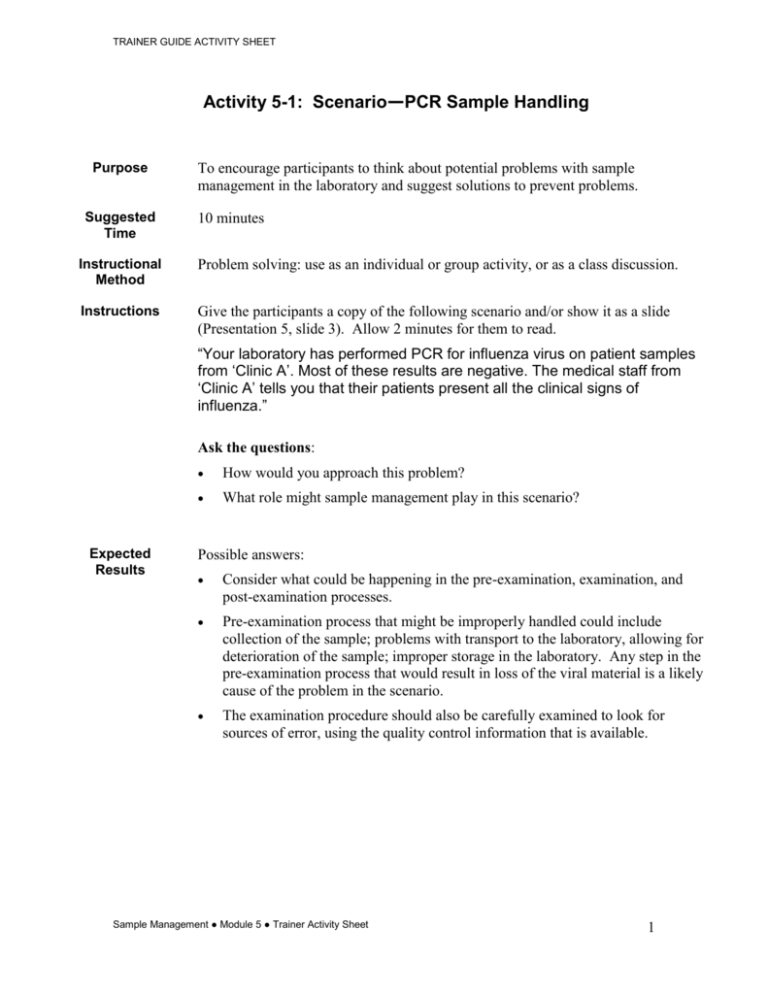
TRAINER GUIDE ACTIVITY SHEET Activity 5-1: Scenario—PCR Sample Handling Purpose Suggested Time To encourage participants to think about potential problems with sample management in the laboratory and suggest solutions to prevent problems. 10 minutes Instructional Method Problem solving: use as an individual or group activity, or as a class discussion. Instructions Give the participants a copy of the following scenario and/or show it as a slide (Presentation 5, slide 3). Allow 2 minutes for them to read. “Your laboratory has performed PCR for influenza virus on patient samples from ‘Clinic A’. Most of these results are negative. The medical staff from ‘Clinic A’ tells you that their patients present all the clinical signs of influenza.” Ask the questions: Expected Results How would you approach this problem? What role might sample management play in this scenario? Possible answers: Consider what could be happening in the pre-examination, examination, and post-examination processes. Pre-examination process that might be improperly handled could include collection of the sample; problems with transport to the laboratory, allowing for deterioration of the sample; improper storage in the laboratory. Any step in the pre-examination process that would result in loss of the viral material is a likely cause of the problem in the scenario. The examination procedure should also be carefully examined to look for sources of error, using the quality control information that is available. Sample Management ● Module 5 ● Trainer Activity Sheet 1 TRAINER GUIDE ACTIVITY SHEET Activity 5-2: Errors in Sample Management Purpose Suggested Time To generate a list of potential sources of error in sample management and describe how each could affect patient care. 15 minutes Instructional Method Brainstorming (entire group) Instructions Give the following task to the participants by projecting it on a slide or by giving it to all participants as a handout. Ask participants: Expected Results Generate a list of possible errors in sample management. How sample management errors could affect patient care? Use a flip chart or blackboard to record the answers that are given by the participants. Possible answers: Examples of potential errors: patient not properly prepared, sample collected from wrong patient, wrong collection medium used, too little sample collected, sample hemolyzed, allowed to sit too long in the clinic or ward, allowed to get too hot while being transported. There are many other possible answers so the group should be able to generate a list of 15 or 20 in a short time. Refer to Annexes 5-B and 5-C. Any errors that occur in the pre-examination phase of testing can give erroneous laboratory results. As a result of erroneous test reporting, the patient may receive the wrong treatment or no treatment; appropriate treatment can be delayed; costly additional tests or treatment may be undertaken; the patient’s condition may worsen considerably while waiting for the right result; and sometimes, inadequate treatment or delay in treatment as a result of a laboratory error can lead to patient death. Sample Management ● Module 5 ● Trainer Activity Sheet 2 TRAINER GUIDE ACTIVITY SHEET Activity 5-3: Hit-or-Myth Game Purpose Suggested Time Instructional Method Instructions Test participant’s knowledge about sample management. 10 minutes Individual or group assignments. Give participants a copy without answers (next page) of 10 statements related to the topic of Sample Management. “Listed below are 10 statements related to the topic of Sample Management. Read each one and decide if you believe it is true – a hit – or false - a myth.” Ask participants to check off their choices on the worksheet. Discuss the answers when everyone has finished. Answer Sheet Hit Myth Statement 1 The laboratory has little influence on how samples are collected by others and submitted to the laboratory for testing. X 2 Requesting clinical information to be submitted with a sample is a breech of patient confidentiality. X 3 The use of transport medium is an unnecessary cost, particularly if collected samples are submitted to the laboratory within the week it was collected. X 4 Only samples contained in containers labeled with a biohazard label should be treated as if it is infectious. X 5 Good, old fashion common sense is a natural friend of laboratory science. It is a sure guide for making sound decisions to accept or reject a sample for testing. X 6 The only requirement of a laboratory receiving samples for confirmation testing is strict adherence to sample rejection criteria. X 7 Samples transported via air must meet IATA regulations. 8 The laboratory can safely assume that if two samples are submitted simultaneously with the same first and last name or birth date, that the 2nd sample is a duplicate and should be discarded. 9 Most tests require samples to be collected in sterile containers. X 10 All samples for testing must be accompanied by a test requisition. X Sample Management ● Module 5 ● Trainer Activity Sheet X X 3 TRAINER GUIDE ACTIVITY SHEET Hit Myth Statement 1 The laboratory has little influence on how samples are collected by others and submitted to the laboratory for testing. 2 Requesting clinical information to be submitted with a sample is a breech of patient confidentiality. 3 The use of transport medium is an unnecessary cost, particularly if collected samples are submitted to the laboratory within the week it was collected. 4 Only samples contained in containers labeled with a biohazard label should be treated as if it is infectious. 5 Good, old fashion common sense is a natural friend of laboratory science. It is a sure guide for making sound decisions to accept or reject a sample for testing. 6 The only requirement of a laboratory receiving samples for confirmation testing is strict adherence to sample rejection criteria. 7 Samples transported via air must meet IATA regulations. 8 The laboratory can safely assume that if two samples are submitted simultaneously with the same first and last name or birth date, that the second sample is a duplicate and should be discarded. 9 Most tests require samples to be collected in sterile containers. 10 All samples for testing must be accompanied by a test requisition. Sample Management ● Module 5 ● Trainer Activity Sheet 4
